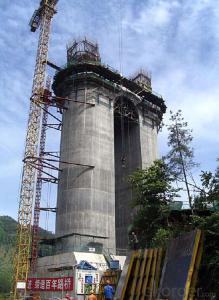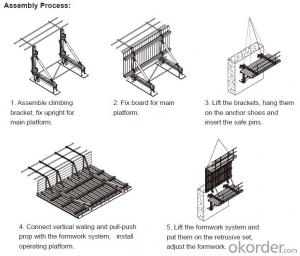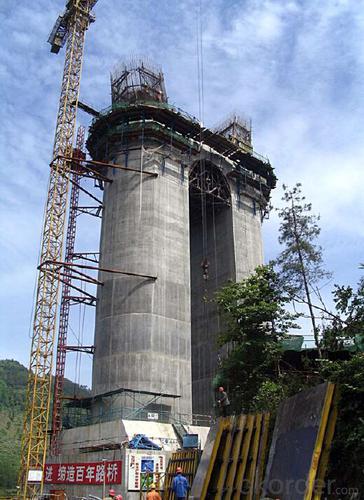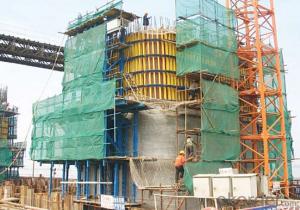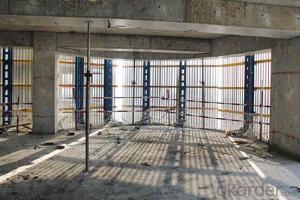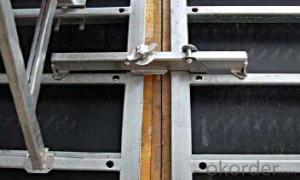Auto Climbing Bracket ACB-100&ACB-50 for Formwork and Scaffolding System
- Loading Port:
- Tianjin
- Payment Terms:
- TT OR LC
- Min Order Qty:
- 50 m²
- Supply Capability:
- 1000 m²/month
OKorder Service Pledge
OKorder Financial Service
You Might Also Like
Auto-climbing Bracket ACB100 & ACB50
The power of the auto-climbing formwork is the hydraulic system, which includes the oil cylinder
and two commutators. The commutators can control the climbing of climbing rail and the bracket.
The steel rail and the bracket can inter-climbing, so the whole system will climb up steadily.
Cranes are not needed during the construction. It’s easy to operate, highly efficient and safe. It’s
the best choice for the construction of high buildings and bridges.
There are mainly two types of standard auto-climbing brackets, ACB-50 and ACB-100, the figure
means the push power of cylinder with unit of KN.
Characteristics:
◆ Perfect load bearing anchor system
Anchor system is the most important supporting part. The system is made of five parts shown
below. Thereinto, tensile bolt, V-climbing cone and washer can be taken out for reusing after the
concrete pouring finished.There are two kinds of anchor systems,A & B. A is matched with single
anchor shoe and B is matched with double anchor shoe.
◆ Crane-independent
Crane-independent forming, striking and climbing speeds up the work procedures on the
construction site and also makes them independent of each other. This means the planned
sequences can be maintained along with guaranteeing high productivity levels. The crane can
therefore be used for other tasks.
Hydraulic system is mainly made of two commutators,
oil cylinder and power distribution system.The
commutators can control the climbing of climbing rail
and bracket.
◆ High bearing capacity and safe
The stable working platforms are able to carry large loads, e.g. the storage of reinforcing steel
for the next climbing section. Generously-sized working platforms, the well thought-out design for
handling very high wind loads and the patented control function of the climbing mechanism are
some of the special details contained within the comprehensive safety concept.
◆ Platforms adjusted to suit the angle of inclination
The horizontal working areas thus created provide safe and comfortable conditions for
reinforcement work, shuttering and striking, concreting and finishing.
◆ The ACB formwork system can climb not only vertically but also slantways, the largest angle is
18 degrees.
◆ The system can climb up wholly or separately. The climbing process is steady, synchronous
and safe.
◆ The bracket will not fall to the ground until the construction is finished, the field will be saved
and the impacting breakage will be reduced (especially the panel).
◆ The system will furnish omnidirectional platform, the construction organizations don’t need to
set up additional operation platform.
◆ The error of structure construction is small and easy to correct.
◆ The climbing speed is fast, the construction course will be quickened.
◆ The formwork can climb itself and cleaning work can be done in the same situs , the used times
of tower crane will be greatly reduced.
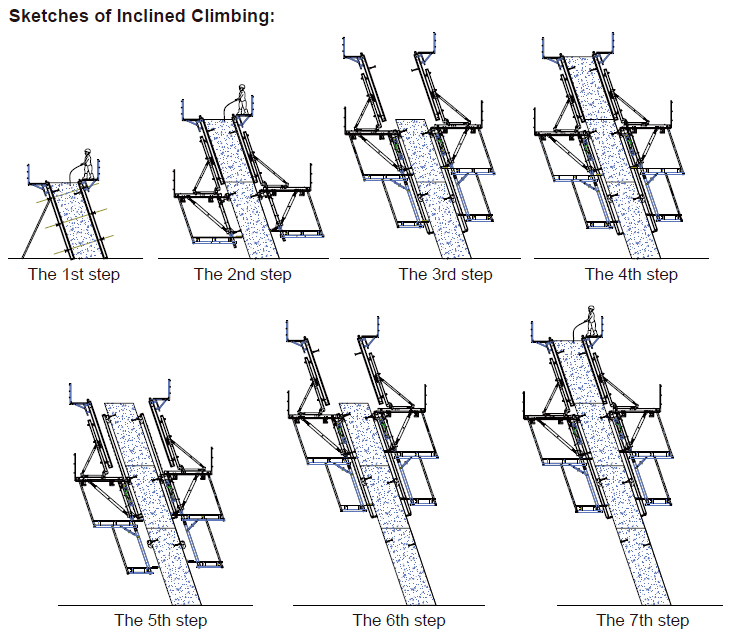
- Q: How do steel formwork systems ensure proper alignment and stability?
- Various features and design elements in steel formwork systems guarantee proper alignment and stability. To begin with, high-quality steel materials are used in the construction of these systems, ensuring exceptional strength and durability. This ensures that the formwork maintains its shape and structure even under heavy loads and adverse weather conditions. Furthermore, interlocking mechanisms and connecting devices are often incorporated into steel formwork systems to securely hold the formwork panels together. These connections provide a tight and precise alignment, preventing any movement or shifting during the concrete pouring process. In addition, adjustable components such as adjustable struts or props are typically included in steel formwork systems. These components allow for easy and accurate leveling and alignment, enabling workers to fine-tune the formwork to the desired position and ensure a level and uniform concrete surface. Moreover, diagonal bracing or cross-bracing elements are commonly incorporated into steel formwork systems to provide added stability and rigidity. These bracing elements help distribute the load evenly across the formwork, minimizing any potential sagging or deformation and ensuring the stability of the structure during the concrete pouring and curing process. Lastly, steel formwork systems are highly versatile and can be customized to fit various shapes and sizes. This flexibility allows for precise alignment to the desired form, guaranteeing that the concrete structure is constructed with the utmost accuracy and stability. In conclusion, steel formwork systems ensure proper alignment and stability through the use of high-quality materials, interlocking mechanisms, adjustable components, bracing elements, and customization options. These features combine to create a reliable and robust formwork system that guarantees the accurate and stable construction of concrete structures.
- Q: What is the cost of steel formwork compared to other types of formwork?
- The cost of steel formwork is generally higher compared to other types of formwork due to its durability, reusability, and strength. While it may have a higher upfront cost, it provides long-term cost benefits over time as it can be used multiple times and requires minimal maintenance.
- Q: Can steel formwork be used for curved structures?
- Curved structures can indeed make use of steel formwork. Steel is an incredibly versatile and robust material that can be easily manipulated and crafted into various shapes, including those with curves. By utilizing advanced technologies like computer-aided design (CAD) and computer-aided manufacturing (CAM), steel formwork can be specifically tailored to meet the precise needs of curved structures. This allows for increased flexibility and innovation in architectural design, empowering engineers and architects to fashion one-of-a-kind and visually captivating curved structures. Furthermore, steel formwork possesses numerous advantages such as longevity, reusability, and the ability to bear substantial loads. These qualities make it an ideal choice for constructing curved structures that necessitate both structural strength and stability.
- Q: How does steel formwork prevent concrete leakage?
- Steel formwork prevents concrete leakage by providing a strong and rigid structure that holds the concrete in place during the pouring and curing process. The steel panels are tightly connected and sealed to prevent any gaps or openings through which the concrete could escape. The formwork panels are designed and assembled in a way that ensures a watertight construction. The joints between the panels are securely fastened and sealed with rubber gaskets or other waterproofing materials. This prevents any seepage or leakage of the concrete mixture. Additionally, steel formwork is typically reinforced with braces and other support systems to maintain its structural integrity and prevent any movement or shifting during the pouring process. This stability ensures that the concrete remains contained within the formwork and doesn't escape through any weak points. Furthermore, the smooth surface of steel formwork prevents the concrete from adhering to it. This allows for easy removal of the formwork after the concrete has cured, without any concrete residue remaining or damaging the structure. Overall, steel formwork provides a reliable and durable solution for preventing concrete leakage. Its strong construction, tight joints, and smooth surface ensure that the concrete remains contained within the formwork, resulting in a high-quality and leak-free concrete structure.
- Q: What are the different types of safety precautions required when working with steel formwork?
- When working with steel formwork, there are several safety precautions that need to be followed to ensure the safety of workers. Some of the different types of safety precautions required include: 1. Personal Protective Equipment (PPE): Workers should wear appropriate PPE such as safety helmets, safety glasses, gloves, and safety shoes to protect themselves from potential hazards like falling objects or sharp edges. 2. Fall Protection: Fall protection measures like guardrails or safety harnesses should be installed to prevent workers from falling off elevated platforms or structures. 3. Adequate Training: Workers should receive proper training on the safe handling and use of steel formwork equipment. They should be educated about the potential risks associated with the work and how to mitigate them. 4. Proper Installation and Maintenance: Steel formwork should be correctly installed and regularly inspected for any defects or damage. Any faulty or damaged parts should be repaired or replaced to ensure the structural integrity of the formwork. 5. Secure Storage: When not in use, steel formwork should be stored in a safe and designated area to prevent accidents caused by improper storage or falling objects. 6. Communication and Signage: Clear communication and signage should be in place to inform workers about potential hazards, safety procedures, and emergency exits. 7. Proper Lifting Techniques: Workers should be trained on proper lifting techniques to avoid strains or injuries when handling heavy steel formwork components. 8. Fire Safety: Fire extinguishers and other fire safety equipment should be readily available on-site to address any fire emergencies. 9. Electrical Safety: If working near electrical equipment or power lines, workers should be trained on electrical safety procedures and take necessary precautions to prevent electrical hazards. 10. Regular Safety Meetings and Inspections: Regular safety meetings should be conducted to address any safety concerns or issues. Additionally, inspections should be carried out periodically to identify and rectify any potential safety hazards. By adhering to these safety precautions, workers can minimize the risk of accidents and injuries while working with steel formwork, ensuring a safe working environment.
- Q: What are the different types of edge protection used with steel formwork?
- There are several types of edge protection used with steel formwork to ensure safety and prevent accidents on construction sites. Some of the common types include: 1. Edge protection barriers: These are typically made of a sturdy material like steel or aluminum and are installed along the edges of the formwork. They act as a physical barrier to prevent workers from accidentally falling off the edge. Edge protection barriers are often adjustable and can be easily installed and removed as needed. 2. Toe boards: Toe boards are typically made of wood or steel and are installed along the lower edge of the formwork. They provide a barrier to prevent tools, equipment, or debris from falling off the edge. Toe boards also serve as a visual indicator, reminding workers to be cautious near the edge. 3. Handrails: Handrails are horizontal bars that are attached to vertical posts and are installed along the edges of the formwork. They provide a secure handhold for workers, helping them maintain balance and stability, especially when working at heights. Handrails are often required by safety regulations in certain situations. 4. Safety nets: Safety nets are installed below the formwork to catch any falling objects or debris. They are typically made of high-strength mesh material and are designed to absorb the impact of a falling object. Safety nets are useful when there is a risk of objects falling off the edge, such as during concrete pouring or during the removal of formwork. 5. Harnesses and lifelines: In certain high-risk situations, workers may be required to wear harnesses and use lifelines to protect themselves from falling. These systems consist of a harness that is worn by the worker and connected to a lifeline, which is securely anchored to a structure. Harnesses and lifelines provide an additional layer of protection in situations where edge protection alone may not be sufficient. It is important to note that the choice of edge protection will depend on the specific requirements of the project, local regulations, and the level of risk associated with the work being performed. It is crucial for construction companies to assess the site conditions and implement appropriate edge protection measures to ensure the safety of workers.
- Q: Can steel formwork be used for projects with aggressive concrete mixes?
- Yes, steel formwork can be used for projects with aggressive concrete mixes. Steel formwork offers high strength, durability, and resistance to chemical reactions, making it suitable for projects involving aggressive concrete mixes. It can withstand the harsh chemical environment created by aggressive concrete mixes and provide a reliable and long-lasting formwork solution.
- Q: Can steel formwork be used for complex geometric shapes?
- Yes, steel formwork can be used for complex geometric shapes. Steel is a highly versatile and flexible material that can be easily molded and shaped to meet the requirements of various intricate designs. It offers excellent strength and durability, making it suitable for constructing formwork for complex architectural and structural shapes. Steel formwork can be fabricated and customized to achieve precise angles, curves, and dimensions, allowing for the creation of intricate and unique shapes in construction projects. Additionally, steel formwork can be reused multiple times, making it a cost-effective option for projects that require complex geometric shapes. Overall, steel formwork provides the necessary flexibility, strength, and durability to successfully accommodate complex architectural and structural designs.
- Q: What are the common cost implications of using steel formwork in a construction project?
- The utilization of steel formwork in a construction project can result in several cost implications, both positive and negative. One of the common cost implications of employing steel formwork is the higher initial investment required in comparison to other formwork materials like timber or aluminum. Steel formwork typically entails a greater upfront purchase or rental expense, which can elevate the initial costs of the project. Nonetheless, it is crucial to take into account the long-term advantages of steel formwork, since its durability and ability to be reused can offset these initial expenditures. Another cost implication of using steel formwork is the reduction in labor and material costs. Steel formwork is renowned for its robustness and capacity to support heavy loads, permitting larger spans and heights to be accomplished with fewer supports. Consequently, less labor and material are necessary for support structures, resulting in potential cost savings. Moreover, the utilization of steel formwork can facilitate increased construction speed and efficiency, which can translate into cost savings. Steel formwork systems are designed for straightforward assembly and disassembly, enabling faster construction cycles. This can aid in diminishing labor costs and overall project duration, thereby minimizing the impact of inflation and other potential cost escalations. Furthermore, the durability and reusability of steel formwork can contribute to long-term cost savings. Unlike timber or plywood formwork, steel formwork can endure multiple uses without significant deterioration. This extends its lifespan and diminishes the need for frequent replacements or repairs, leading to financial savings on material costs in the long run. However, it is important to acknowledge that steel formwork may necessitate additional expenses for transportation and storage. Steel formwork is heavier and bulkier than alternative materials, which can augment transportation costs. Additionally, proper storage and maintenance are vital to ensure the longevity of steel formwork, which may entail supplementary expenses for cleaning, rust prevention, and storage facilities. To conclude, although there may be higher initial costs involved in employing steel formwork in a construction project, the long-term benefits of durability, reuse, reduced labor, and increased construction speed can outweigh these expenses. A thorough evaluation of the specific project requirements, budget, and timeline is necessary to ascertain whether the cost implications of using steel formwork are advantageous for a particular construction project.
- Q: How does steel formwork handle formwork alignment and leveling?
- The steel formwork system is a highly efficient and versatile solution that excels in the management of formwork alignment and leveling. It possesses numerous features and mechanisms that guarantee precise and accurate formwork placement. To begin with, the robustness and rigidity of steel formwork enable it to maintain its shape and dimensions throughout the pouring and curing of concrete. This inherent stability ensures that the formwork remains aligned and level during the entire construction process. Furthermore, steel formwork often incorporates adjustable components like screws, wedges, and clamps. These elements allow for fine-tuning of the formwork's position and elevation, facilitating precise alignment and leveling. By simply adjusting these components, workers can easily rectify any deviations and ensure perfect formwork alignment. Additionally, steel formwork systems frequently utilize integrated leveling systems. These systems typically consist of hydraulic jacks or mechanical devices that provide controlled and precise leveling. By utilizing these mechanisms, workers can effortlessly adjust the formwork's height and maintain a consistent level across the entire structure. Moreover, steel formwork possesses the ability to withstand significant loads and pressures exerted by the concrete during pouring. This strength enables it to resist any deformation or deflection, ensuring that the formwork remains aligned and level even under challenging conditions. In conclusion, the steel formwork system offers exceptional capabilities in managing formwork alignment and leveling. Its inherent stability, adjustable components, integrated leveling systems, and strength make it a reliable choice for maintaining the desired accuracy and precision during concrete construction projects.
Send your message to us
Auto Climbing Bracket ACB-100&ACB-50 for Formwork and Scaffolding System
- Loading Port:
- Tianjin
- Payment Terms:
- TT OR LC
- Min Order Qty:
- 50 m²
- Supply Capability:
- 1000 m²/month
OKorder Service Pledge
OKorder Financial Service
Similar products
Hot products
Hot Searches
